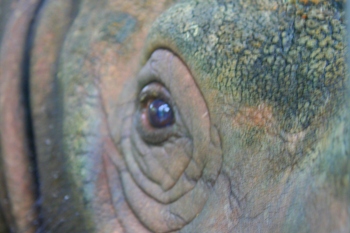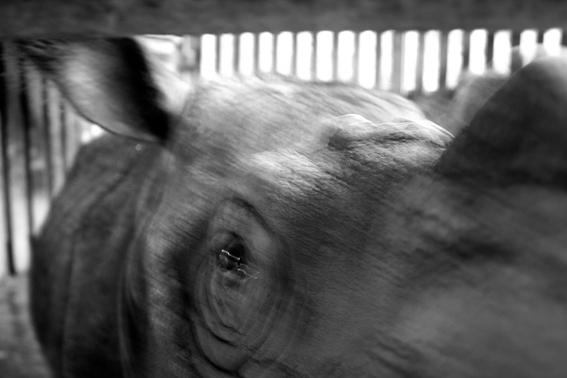Meeting Tam in Borneo: our last chance to save Asia’s two horned rhino
Nothing can really prepare a person for coming face-to-face with what may be the last of a species.
I had known for a week that I would be fortunate enough to meet Tam. I’d heard stories of his gentle demeanor, discussed his current situation with experts, and read everything I could find about this surprising individual. But still, walking up to the pen where Tam stood contentedly pulling leaves from the hands of a local ranger, hearing him snort and whistle, watching as he rattled the bars with his blunted horn, I felt like I was walking into a place I wasn’t meant to be. As though I was treading on his, Tam’s space: entering into a cool deep forest where mud wallows and shadows still linger. This was Tam’s world, or at least it should be.
A living—still surviving—Bornean rhinoceros, Tam is only one of an estimated forty left in the world, maybe less. At 620 kilograms (1430 pounds), Tam is a full grown male rhino. Researchers have estimated his age to be about twenty with at least another decade before him. Surprisingly pinkish in color, he is sparsely covered by large black hairs, while both of his two horns—unlike other Asian rhinos who only sport one—have been rubbed dull against the walls of his pen.
 Eye to eye with Tam. Photo by: Jeremy Hance. |
Tam is a survivor—that is certain. He survived his forest habitat being whittled into smaller and smaller pockets. He survived his right foot being caught in a poacher’s snare leaving an inch-wide white scar circling his ankle. And he survived when he wandered directly into an oil palm plantation in early August of last year, probably propelled by his injury. He had beaten the odds, this one.
Everything has changed for Tam now. Cynthia Ong, Director of Land Empowerment Animals and People (LEAP) which has worked on raising funds to save the Bornean rhino, said that since wandering into a plantation over a year ago Tam had become “very manja”. Not being Malaysian I didn’t know the word, but she assured me every Malaysian mother’s daughter knew it, and it meant something like ‘lovingly spoiled’.
It’s true that Tam has entered a kind of retirement. Instead of being butchered for his horn—a fate suffered by a female Bornean rhino in 2001—Tam was immediately seen as a symbol of a dying, but not yet dead, species. His surprising arrival on an oil palm plantation brought the government and conservation community of Sabah into action. He now has a 2.5 hectare pen to his own, complete with forest cover and two mud wallows; he is fed a selection of greens gathered every morning and afternoon by rangers with the Sabah Wildlife Department; and he is protected 24-7 by an anti-poaching squad.
 Tam at dinner time. Photo by: Jeremy Hance. |
Of course, the situation is not perfect, it would be best if Tam could have remained in the wild to live out his life—only this time near other rhinos, instead of the forest patch where he was trapped and alone. But his injured foot had required care and now he is too accustomed to humans to simply be placed back in the wild, because he would likely wander into human habitations again—where he may not be so lucky.
However his appearance on the human stage has given Tam another role to play: a survivor’s role.
Tam—this massive, purplish, very ‘manja’ animal who almost crushed my hand against the bars as I tried to take rapid photos into his pen because he probably thought I was trying to feed him the camera—could be the key to bringing the Bornean rhino back from the brink.
The story of the two-horned Asian rhino
The story of Tam and his kind goes back—way back.
Bornean rhinos are actually a subspecies of the Sumatran rhino, of which there are only an estimated 250 left in the world. Sumatran rhinos—and their Bornean subspecies—are the only rhinos left in the genus, Dicerorhinus. Most researchers believe that the Sumatran rhino is the last living representative of early Miocene rhinos and therefore the oldest rhino species left in the world, one that emerged between 15 and 20 million years ago.
 The hair that links Sumatran rhinos to Woolly rhinos. Photo by: Jeremy Hance. |
This also makes the Sumatran rhino the closest living relative to the legendary Woolly rhinoceros, which roamed the steppes during the Ice Age. Evidence of their ancient ancestry is seen in the Sumatran rhinos’ thick black strands of hair; the same hair that probably covered the Woolly rhinoceros, only in a far thicker coat.
For millions of years the Sumatran rhino inhabited Southeast Asia, from Borneo to Northeastern India. Living largely solitary lives, they preferred deep tropical forests near muddy and swampy areas. Not known to fight over territory, the Sumatran rhino is actually quite a gentle creature, despite its heavy bulk and huge horns. Considered the most vocal of all the rhinos, it makes a number of surprising noises, including one which has been compared to a whale singing.
After millions of years the rhino’s fate turned. Following the path similar to many lost and threatened species in the region, habitat loss and large-scale hunting drove the rhino into smaller and smaller pockets until it finally reached its current pathetic state. The rhino’s horn is key to understanding the demise of the animal; it fetches hefty prices (upwards of 30,000 US dollars per kilo) on the black market where it is sold as traditional Chinese medicine. Despite decades of anti-poaching measures and laws, the trade is still booming and rhinos across the world are still paying the price. In fact this year has been a particularly bad one for rhinos worldwide: poaching is at a fifteen-year-high and rhino horn by kilo is not worth more than gold.
The Sumatran rhino has already lost one subspecies to extinction—the Northern Sumatran rhino, once prevalent in India, Burma, and Bangladesh—while the remaining two subspecies—the Bornean and the Western Sumatran rhino—hang-on by a thread in Borneo, Sumatra, and peninsular Malaysia.
The rest of this article is now only available to subscribers. An updated version is also published in Jeremy Hance’s book, Life is Good: Conservation in an Age of Mass Extinction, which was released in January 2012.

Tam coming a little close to the camera. Photo by: Jeremy Hance

Tam. Photo by: Jeremy Hance
Related articles
In midst of poaching crisis, illegal rhino horn tops gold
(11/25/2009) Rhino poaching has hit a fifteen-year high, and the rising price for black-market rhino horn is likely the reason why. For the first time in a decade rhino horn is worth more than gold: a kilo of rhino horn is worth approximately 60,000 US dollars while gold is a little over 40,600 US dollars.
World’s only Sumatran rhino to give birth in captivity dies at Cincinnati Zoo
(09/10/2009) Emi, the world’s only Sumatran rhino to give birth in captivity, died on Saturday at the Cincinnati zoo. She successfully gave birth to three offspring, one of which has been released back into the wild in Indonesia.
Rhino poaching rises sharply due to Asian demand for horns
(07/09/2009) Rhino poaching rates have hit a 15-year-high as a consequence of demand for horns for use in traditional medicine, according to new report published by the wildlife trade monitoring network TRAFFIC. Asia-based criminal gangs run the illegal trade.
Rarest rhino caught on film wallowing in mud with calf
(03/06/2009) In a scene that appears out of an old jungle movie, The World Wildlife Fund (WWF) has caught the world’s rarest rhino on film. With less than 60 Javan rhinos estimated to exist in the wild, it is one of the world’s most imperiled species.
Scientists capture video of rare Borneo rhino

(04/24/2007) WWF has captured video footage of the rare Borneo rhino. There are only 25-50 of the rhino left in the wild on the island. Video from a camera trap shows the animal eating, walking to the camera and sniffing the equipment. It is first time the beast’s behvaior in the wild has been captured on film.
Rhino horn nothing more than keratin, calcium, and melanin confirms research
(11/06/2006) Rhinoceros horns have long been objects of mythological beliefs. Some cultures prize them for their supposed magical or medicinal qualities. Others have used them as dagger handles or good luck charms. But new research at Ohio University removes some of the mystique by explaining how the horn gets its distinctive curve and sharply pointed tip.
13 rare rhinos found in Borneo survey by WWF
(03/17/2006) World Wildlife Fund today released the results of a field survey from the island of Borneo which found that poaching has significantly reduced Borneo’s population of Sumatran rhinos, but a small group continues to survive in the “Heart of Borneo,” a region covered with vast tracts of rain forest.







